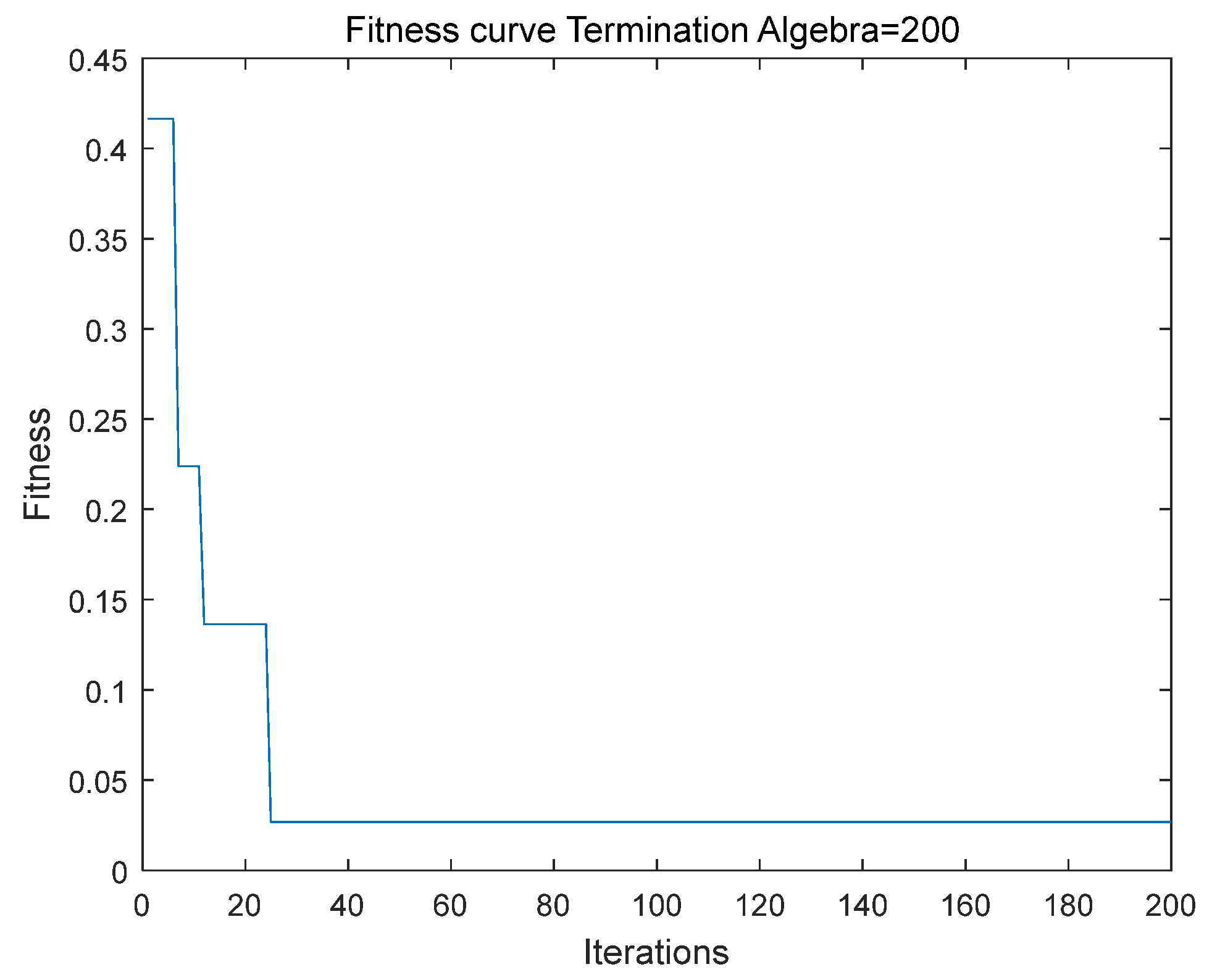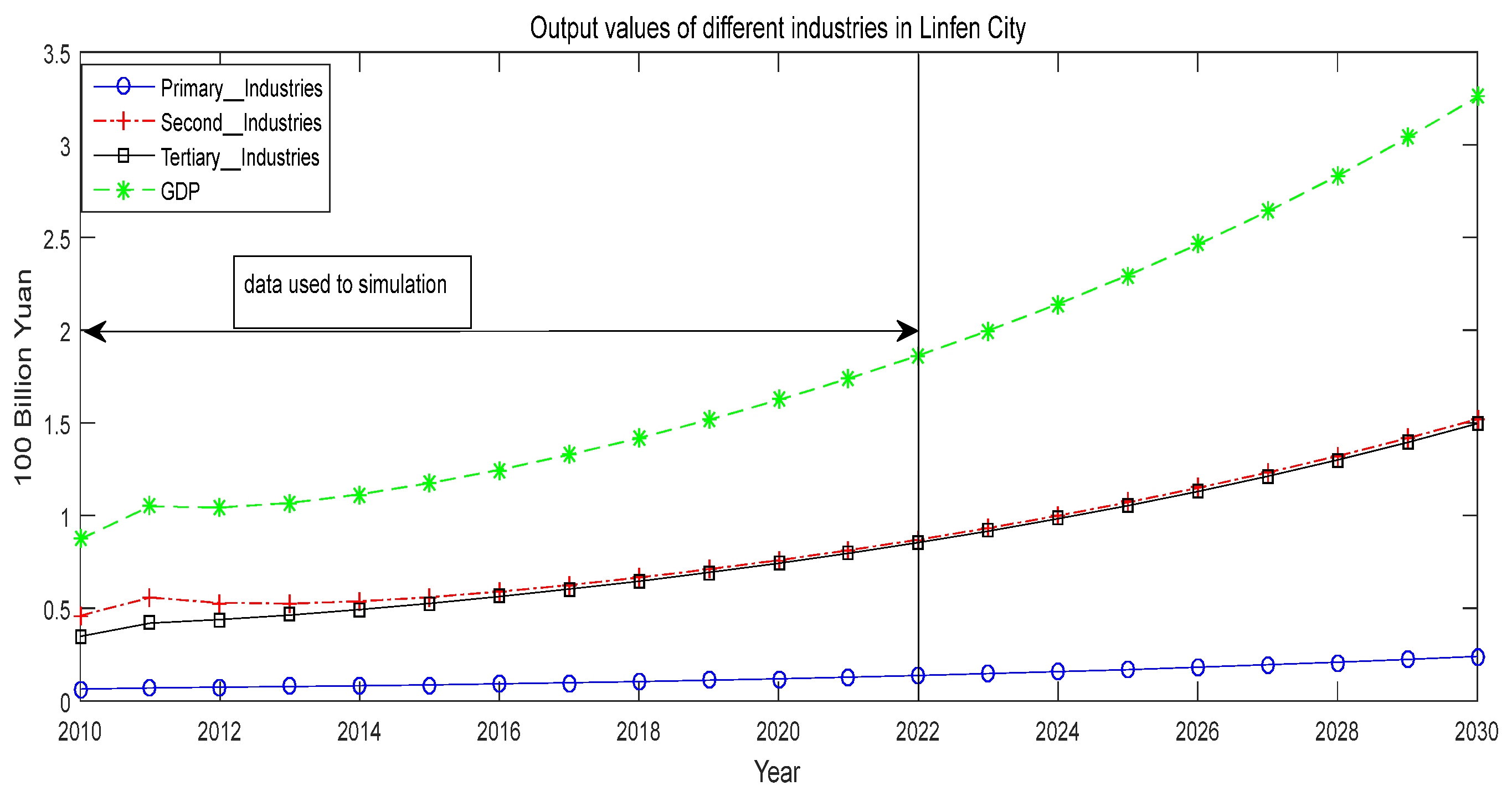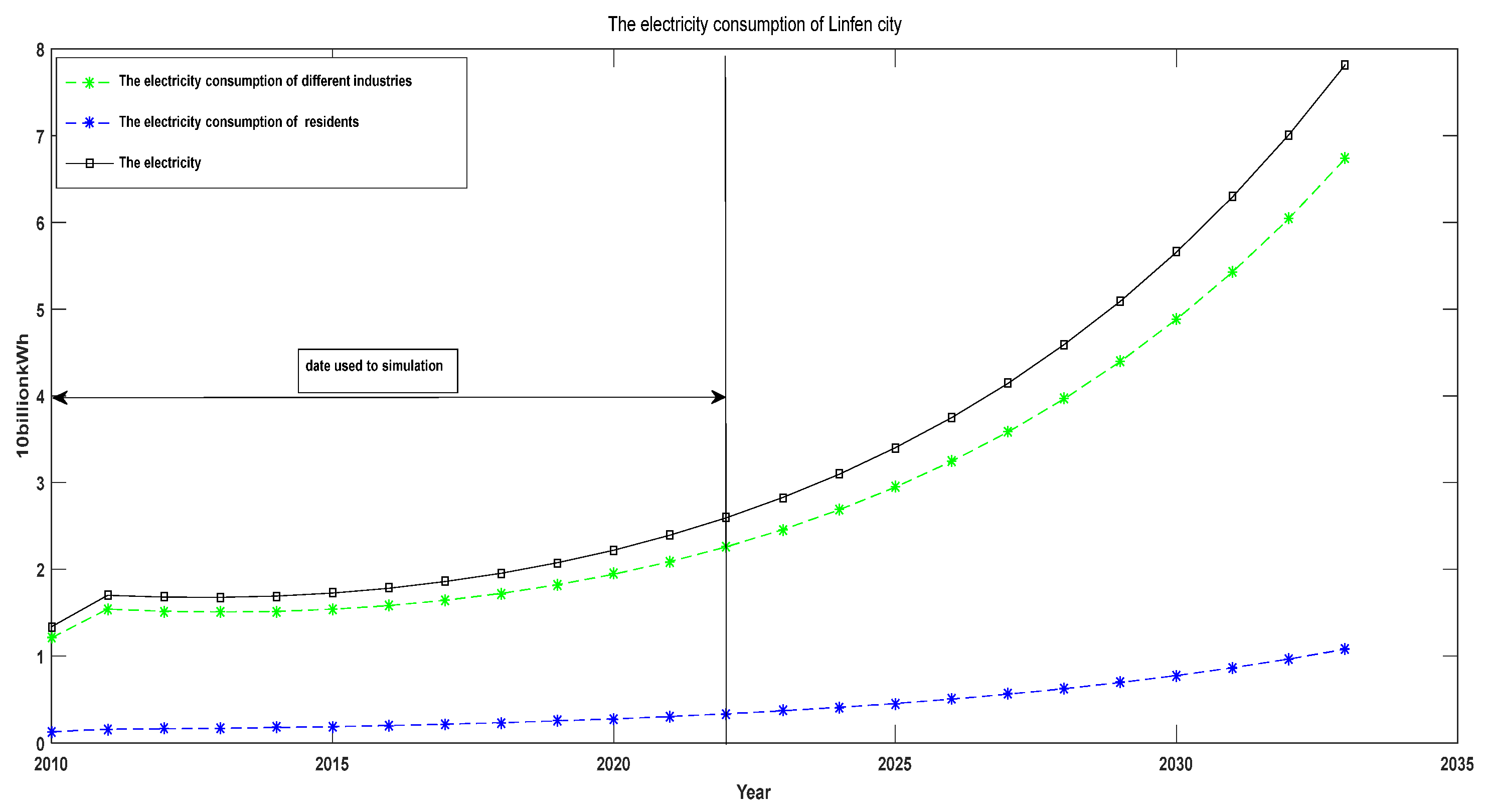An Improved MGM (1, n) Model for Predicting Urban Electricity Consumption
Abstract
1. Introduction
2. Data and Methods
2.1. Data Source
2.2. Logarithmic Mean Divisia Index (LMDI) Method
2.2.1. The Index Decomposition Method
2.2.2. The Improved MGM (1, n) Model
2.2.3. Assessment of the Improved MGM (1, n) Model Forecasting Precision
2.2.4. Particle Swarm Optimization
2.2.5. Validation of the Improved MGM (1, n) Model
3. Empirical Results and Discussion
3.1. The Driving Factors of Electricity Demand in Linfen City
3.1.1. The Driving Factors of Industrial Electricity Consumption
3.1.2. The Driving Factor of Residential Electricity Consumption
3.2. Forecasting Results
3.2.1. The Forecasting Results of GDP
3.2.2. Prediction of Electricity Consumption in Linfen City
4. Conclusions
Supplementary Materials
Author Contributions
Funding
Data Availability Statement
Conflicts of Interest
References
- Somu, N.; Raman, G.; Ramamritham, K. A deep learning framework for building energy consumption forecast. TERI Inf. Dig. Energy Environ. 2021, 1, 20. [Google Scholar] [CrossRef]
- Juan, M.; Vikram, P.; Bidisha, G. A spiking neural network based wind power forecasting model for neuromorphic devices. Energies 2022, 15, 7256. [Google Scholar] [CrossRef]
- Wen, M.; Yu, Z.C.; Li, W.Y.; Luo, S.C.; Zhong, Y.; Chen, C.Q. Short-term load forecasting based on feature mining and deep learning of big data of user electricity consumption. AIP Adv. 2023, 13, 125315. [Google Scholar] [CrossRef]
- Eskandar, E.M.; Alammal, H.; Almadany, W. What prophet says about electrical consumption—Forecasting techniques for big temporal data. IET Conf. Proc. 2020, 2020, 543–548. [Google Scholar]
- Amalou, I.; Mouhni, N.; Abdali, A. Multivariate time series prediction by RNN architectures for energy consumption forecasting. Energy Rep. 2022, 8, 1084–1091. [Google Scholar] [CrossRef]
- Chen, H.Y.; Le, C.H.; Huang, B.M. Electricity consumption forecasting of buildings using hierarchical ANFIS and GRA. In Proceedings of the 2019 International Conference on Machine Learning and Cybernetics (ICMLC), Kobe, Japan, 7–10 July 2019. [Google Scholar]
- Wen, L.; Song, Q. The forecasting model research of rural energy transformation in Henan Province based on STIRPAT model. Environ. Sci. Pollut. Res. Int. 2022, 29, 75550–75565. [Google Scholar] [CrossRef] [PubMed]
- Nadja, K.; Michael, S.S.; David, J.N. Deep distributional time series models and the probabilistic forecasting of intraday electricity prices. J. Appl. Econom. 2023, 38, 493–511. [Google Scholar]
- Zhan, L.P.; Gu, Y. Research on multi-scenario intelligent forecasting model of china’s electric power consumption driven by policy. IOP Conf. Ser. Earth Environ. Sci. 2019, 332, 042020. [Google Scholar] [CrossRef]
- Zhao, H.; Guo, S. An optimized grey model for annual power load forecasting. Energy 2016, 107, 272–286. [Google Scholar] [CrossRef]
- Wang, Z.X. A predictive analysis of clean energy consumption, economic growth and environmental regulation in China using an optimized grey dynamic model. Comput. Econ. 2015, 46, 437–453. [Google Scholar] [CrossRef]
- Wang, Z.X.; Hao, P. An improved grey multivariable model for predicting industrial energy consumption in China. Appl. Math. Model. 2016, 40, 5745–5758. [Google Scholar] [CrossRef]
- Wang, Z.X.; Li, Q.; Pei, L.L. Grey forecasting method of quarterly hydropower production in China based on a data grouping approach. Appl. Math. Model. 2017, 51, 302–316. [Google Scholar] [CrossRef]
- Lee, Y.S.; Tong, L.I. Forecasting energy consumption using a grey model improved by incorporating genetic programming. Energy Convers. Manag. 2011, 52, 147–152. [Google Scholar] [CrossRef]
- Wang, Z.X.; Ye, D.J. Forecasting Chinese carbon emissions from fossil energy consumption using non-linear grey multivariable models. J. Clean. Prod. 2017, 142, 600–612. [Google Scholar] [CrossRef]
- Feng, Z.X.; Zhang, M.Q.; Wei, N.; Zhao, J.T.; Zhang, T.L.; He, X. An office building energy consumption forecasting model with dynamically combined residual error correction based on the optimal model. Energy Rep. 2022, 8, 12442–12455. [Google Scholar] [CrossRef]
- Mehrnoosh, T.; Sattar, H.; Reza, S.M.; Shahaboddin, S.; Amir, M. A hybrid clustering and classication technique for forecasting short-term energy consumption. Environ. Prog. Sustain. Energy 2018, 38, 66–76. [Google Scholar]
- Succetti, F.; Luzio, F.D.; Ceschini, A.; Rosato, A.; Araneo, R.; Panella, M. Multivariate prediction of energy time series by autoencoded LSTM networks. In Proceedings of the 2021 IEEE International Conference on Environment and Electrical Engineering and 2021 IEEE Industrial and Commercial Power Systems Europe (EEEIC/I&CPS Europe), Bari, Italy, 7–10 September 2021. [Google Scholar]
- Magazzino, C.; Mutascu, M.; Mele, M.; Sarkodie, S.A. Energy consumption and economic growth in Italy: A wavelet analysis. Energy Rep. 2021, 7, 1520–1528. [Google Scholar] [CrossRef]
- Chen, M.Y. Decoupling of energy consumption from economic growth in BRICS in the context of novel coronavirus pneumonia based on tapio decoupling index. Basic Clin. Pharmacol. Toxicol. 2020, 127, 238. [Google Scholar]
- Kong, L.; Mu, X.; Hu, G. A decomposing analysis of productive and residential energy consumption in Beijing. Energy 2021, 226, 120413. [Google Scholar]
- Liu, X.; Zhou, D.; Zhou, P.; Wang, Q. Factors driving energy consumption in China: A joint decomposition approach. J. Clean. Prod. 2018, 172, 724–734. [Google Scholar] [CrossRef]
- Rocío, R.C.; Colinet, M.J. Are labor productivity and residential living standards drivers of the energy consumption changes? Energy Econ. 2018, 74, 746–756. [Google Scholar]
- Ge, Y.H.; Yuan, R. Exploring decoupling relationship between ICT investments and energy consumption in China’s provinces: Factors and policy implications. Energy 2024, 286, 129506. [Google Scholar] [CrossRef]
- Wang, W.X.; Zhang, W.; Cui, H.R.; Liu, B. Application of grey multi-variable model MGM (1, n) in the R & D investment forecast. RD Manag. 2006, 18, 92–96. [Google Scholar]
- Wang, F.X. Multivariable non-equidistance MGM (1, m) model and its application. Syst. Eng. Electron. 2007, 29, 389–390. [Google Scholar]
- Xiong, P.P.; Dang, Y.G.; Wang, Z.X. Optimization of background value in MGM (1, m) model. Control Decis. 2011, 26, 806–815. [Google Scholar]
- Chen, C.P.; Liu, F.X.; Xu, Z.D. The research on optimized multi-variable grey model and its application. Math. Pract. Theory 2016, 46, 199–205. [Google Scholar]
- Xiong, P.P.; Dang, Y.G.; Shu, H. Research on characteristics of MGM (1, m) model. Control Decis. 2012, 26, 389–393. [Google Scholar]
- Wu, L.; Zhang, Z. Grey multivariable convolution model with new information priority accumulation. Appl. Math. Model. 2018, 62, 595–604. [Google Scholar] [CrossRef]
- Ma, X.; Hu, Y.S.; Liu, Z.B. A novel kernel regularized nonhomogeneous grey model and its applications. Commun. Nonlinear Sci. Numer. Simul. 2017, 48, 51–62. [Google Scholar] [CrossRef]
- Zeng, L. Analysing the high-tech industry with a multivariable grey forecasting model based on fractional order accumulation. Kybernetes 2018, 48, 1158–1174. [Google Scholar] [CrossRef]
- Kenndy, J.; Eberhart, R.C. Particle swarm optimization. In Proceedings of the IEEE International Conference on Neural Networks, Perth, Australia, 27 November–1 December 1995; Volume 4, pp. 1942–1948. [Google Scholar]




| k | MGM (1, 2) | IMGM (1, 2) | Improved MGM (1, 2) | |||
|---|---|---|---|---|---|---|
| (1–7) | A | B | A | B | A | B |
| MAPE (%) | 0.284 | 0.163 | 0.044 | 0.078 | 0.020 | 0.018 |
| k | Actual Value | MGM (1, 2) | IMGM (1, 2) | Improved MGM (1, 2) | ||||
|---|---|---|---|---|---|---|---|---|
| 8 | 31.67 | 33.97 | 31.54 | 33.86 | 31.66 | 33.99 | 31.67 | 33.95 |
| 9 | 37.55 | 38.29 | 37.36 | 38.17 | 37.52 | 38.38 | 37.53 | 38.27 |
| k | MGM (1, 2) | IMGM (1, 2) | Improved MGM (1, 2) | |||
|---|---|---|---|---|---|---|
| 8 | 0.411 | 0.324 | 0.032 | 0.059 | 0.012 | 0.060 |
| 9 | 0.506 | 0.313 | 0.080 | 0.235 | 0.049 | 0.046 |
| MAPE (%) | 0.459 | 0.319 | 0.056 | 0.147 | 0.031 | 0.053 |
| RMSE | 0.2055 | 0.1151 | 0.736 | 0.0652 | 0.0652 | 0.02 |
| Year | ||||
|---|---|---|---|---|
| 2011 | 53,199.74 | −132,894 | 43,317.66 | 142,775.7 |
| 2012 | 258,306.5 | −27,275.4 | 33,601.71 | 251,980.1 |
| 2013 | 402,640.2 | 66,553.8 | −17,913.8 | 354,000.2 |
| 2014 | 515,845.8 | 98,037.6 | −65,516.7 | 483,324.8 |
| 2015 | 369,863.1 | 97,469.4 | −12,5161 | 397,554.5 |
| 2016 | 423,062.3 | 118,228.1 | −15,6176 | 461,010.7 |
| 2017 | 256,254.5 | −35,982.1 | −15,6070 | 448,307.2 |
| 2018 | 318,246.8 | 60,838.6 | −19,4715 | 452,123.7 |
| 2019 | 506,871.5 | 112,777.7 | −21,6961 | 611,054.5 |
| 2020 | 845,671.5 | 192,952.4 | −23,6792 | 889,511.4 |
| 2021 | 1,083,334 | −246,456 | −65,114.9 | 1,394,905 |
| 2022 | 968,506.8 | −586,773 | 64,350.83 | 1,490,928 |
| Year | ||||
|---|---|---|---|---|
| 2011 | −9969.59 | −9969.59 | 33,115.4 | −1295.82 |
| 2012 | 445.0893 | 445.0893 | 39,827.92 | −2775.01 |
| 2013 | 4926.278 | 4926.278 | 43,482.36 | −4286.64 |
| 2014 | 17,195.26 | 17,195.26 | 43,876.43 | −5689.68 |
| 2015 | 23,690.13 | 23,690.13 | 38,292.49 | −6877.62 |
| 2016 | 34,352.55 | 34,352.55 | 44,045.56 | −8306.12 |
| 2017 | 24,946.75 | 24,946.75 | 72,485.09 | −9847.84 |
| 2018 | 32,565.05 | 32,565.05 | 91,675.15 | −12,336.2 |
| 2019 | 30,257.12 | 30,257.12 | 106,881 | −14,154.1 |
| 2020 | 38,849.57 | 38,849.57 | 120,250.5 | −16,116 |
| 2021 | 15,108.46 | 15,108.46 | 179,440.9 | −20,241.3 |
| 2022 | 12,891.09 | 12,891.09 | 228,620.9 | −22,203.9 |
| Year | Primary Industry | Secondary Industry | Tertiary Industries | GDP |
|---|---|---|---|---|
| 2023 | 0.148056 | 0.932828 | 0.916491 | 1.997375 |
| 2024 | 0.158663 | 0.999766 | 0.982936 | 2.141365 |
| 2025 | 0.170074 | 1.071757 | 1.054226 | 2.296056 |
| 2026 | 0.182338 | 1.149116 | 1.130707 | 2.462161 |
| 2027 | 0.195512 | 1.232199 | 1.212752 | 2.640464 |
| 2028 | 0.209658 | 1.321395 | 1.300762 | 2.831814 |
| 2029 | 0.224841 | 1.417126 | 1.395167 | 3.037135 |
| 2030 | 0.241135 | 1.519854 | 1.496431 | 3.25742 |
| Year | (100 Billion kWh) | (100 Billion kWh) | (100 Billion kWh) |
|---|---|---|---|
| 2023 | 2.450 | 0.368 | 2.818 |
| 2024 | 2.678 | 0.408 | 3.086 |
| 2025 | 2.939 | 0.452 | 3.391 |
| 2026 | 3.236 | 0.5020 | 3.738 |
| 2027 | 3.572 | 0.558 | 4.13 |
| 2028 | 3.953 | 0.621 | 4.574 |
| 2029 | 4.382 | 0.692 | 5.074 |
| 2030 | 4.866 | 0.771 | 5.637 |
Disclaimer/Publisher’s Note: The statements, opinions and data contained in all publications are solely those of the individual author(s) and contributor(s) and not of MDPI and/or the editor(s). MDPI and/or the editor(s) disclaim responsibility for any injury to people or property resulting from any ideas, methods, instructions or products referred to in the content. |
© 2024 by the authors. Licensee MDPI, Basel, Switzerland. This article is an open access article distributed under the terms and conditions of the Creative Commons Attribution (CC BY) license (https://creativecommons.org/licenses/by/4.0/).
Share and Cite
Li, Z.; Lu, J. An Improved MGM (1, n) Model for Predicting Urban Electricity Consumption. Energies 2024, 17, 3872. https://doi.org/10.3390/en17163872
Li Z, Lu J. An Improved MGM (1, n) Model for Predicting Urban Electricity Consumption. Energies. 2024; 17(16):3872. https://doi.org/10.3390/en17163872
Chicago/Turabian StyleLi, Zhenhua, and Jinghua Lu. 2024. "An Improved MGM (1, n) Model for Predicting Urban Electricity Consumption" Energies 17, no. 16: 3872. https://doi.org/10.3390/en17163872
APA StyleLi, Z., & Lu, J. (2024). An Improved MGM (1, n) Model for Predicting Urban Electricity Consumption. Energies, 17(16), 3872. https://doi.org/10.3390/en17163872




